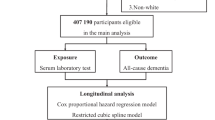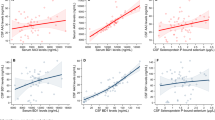Abstract
Objective: To analyse the relation between antioxidant vitamins A, E, and malondialdehyde (MDA) lipoperoxidation product plasma concentrations with incident dementia.
Design: A nested case–control within the PAQUID (Personnes Agées QUID) cohort.
Setting: The PAQUID population-based prospective cohort in southwestern France.
Subjects: Among 626 subjects with blood collection at baseline, 46 developed a dementia during the follow-up and were considered to be cases. Each case was matched (on age and sex) to three controls.
Results: Plasma vitamin E concentrations were lower among cases (mean value at 22.62 μmol/l (s.d.: 7.38) vs 24.99 (s.d.: 6.73 among controls). The same trend was observed for vitamin A concentrations, but the difference was not significant. On the contrary, MDA concentrations tended to be higher (mean value 1.35 μmol/l (s.d.: 0.53) vs 1.23 (s.d.: 0.44)) among cases. In logistic regression models, plasma values were split into tertiles. Adjusted for confounders, the risk of dementia was significantly increased in the lowest vitamin E tertile (≤21.0 μmol/l) (OR=3.12, P=0.033) compared to the highest one (≥25.5 μmol/l). The risk of Alzheimer's disease was also increased, with borderline significance (OR=3.06, P=0.053). Risks associated with vitamin A were nonsignificant. Similarly, there was a trend to an increased risk of dementia in the highest tertile of MDA (OR=1.67, P=0.31).
Conclusions: These results suggest that subjects with low plasma vitamin E concentrations are at a higher risk of developing a dementia in subsequent years.
This is a preview of subscription content, access via your institution
Access options
Subscribe to this journal
Receive 12 print issues and online access
$259.00 per year
only $21.58 per issue
Buy this article
- Purchase on Springer Link
- Instant access to full article PDF
Prices may be subject to local taxes which are calculated during checkout

Similar content being viewed by others
References
American Psychiatric Association (1987): Diagnostic and Statistical Manual of Mental Disorders, 3rd Edition Revised (DSM III-R). Washington: APA.
Barberger-Gateau P, Fabrigoule C, Helmer C, Rouch I & Dartigues JF (1999): Functional impairment in instrumental activities of daily living: an early clinical sign of dementia? J Am Geriatr Soc 47, 456–462.
Behl C (1999): Vitamin E and other antioxidants in neuroprotection. Int J Vitam Nutr Res 69, 213–219.
Bourdel-Marchasson I, Delmas-beauvieux MC, Peuchant E, Richard-Harston S, Decamps A, Reignier B, Emeriau JP & Rainfray M (2001): Antioxidant defences and oxidative stress markers in erythrocytes and plasma from normally nourished elderly Alzheimer patients. Age Ageing, 30, 235–241.
Carbonneau MA, Peuchant E, Sess D, Canioni P & Clerc M (1991): Free and bound malondialdehyde measured as thiobarbituric acid product by HPLC in serum and plasma. Clin Chem 37, 1423–1429.
Chandra RK (2001): Effect of vitamin and trace-element supplementation on cognitive function in elderly subjects. Nutrition 17, 709–712.
Christen Y (2000): Oxidative stress and Alzheimer's disease. Am J Clin Nutr 71, 621S–629S
Dartigues JF, Gagnon M, Michel P, Letenneur L, Commenges D, Barberger-Gateau P, Auriacombe S, Rigal B, Bédry R, Alperovitch A, Orgogozo JM, Henry P, Loiseau P & Salamon R (1991): Le programme de recherche Paquid sur l'épidémiologie de la démence. Méthodologie et résultats initiaux. Rev Neurol 147, 225–230.
Deschamps V, Barberger-Gateau P, Peuchant E & Orgogozo JM (2001): Nutritional factors in cerebral aging and dementia: epidemiological arguments for a role of oxidative stress. Neuroepidemiology 20, 7–15.
Engelhart MJ, Geerlings MI, Ruitenberg A, van Swieten JC, Hofman A, Witteman JCM & Breteler MMB (2002): Dietary intake of antioxidants and risk of Alzheimer's disease. JAMA 287, 3223–3229.
Farrer LA, Cupples LA, Haines JL, Hyman B, Kukull WA, Mayeux R, Myers RH, Pericak-Vance MA, Risch N & van Duijn CM (1997): Effects of age, sex, and ethnicity on the association between apolipoprotein E genotype and Alzheimer's disease. A meta-analysis. APOE and Alzheimer's Disease Meta Analysis Consortium. JAMA 278, 1349–1356.
Folstein MF, Folstein SE & McHugh PR (1975): “Mini Mental State”. A practical method for grading the cognitive state of patients for the clinician. J Psychiatr Res 12, 189–198.
Goodman Y & Mattson MP (1994): Secreted forms of beta-amyloid precursor protein protect hippocampal neurons against amyloid beta-peptide-induced oxidative injury. Exp Neurol 128, 1–12.
Grundman M (2000): Vitamin E and Alzheimer's disease: the basis for additional clinical trials. Am J Clin Nutr 71, 630S–636S.
Gutteridge JM (1975): The use of standards for malonyldialdehyde. Anal Biochem 69, 518–526.
Haller J, Weggemans RM, Ferry M & Guigoz Y (1996): Mental health: minimental state examination and geriatric depression score of elderly Europeans in the SENECA study of 1993. Eur J Clin Nutr 50 (Suppl 2), S112–116.
Harkany T, Mulder J, Sasvari M, Abraham I, Konya C, Zarandi M, Penke B, Luiten PG & Nyakas C (1999): N-Methyl-D-aspartate receptor antagonist MK-801 and radical scavengers protect cholinergic nucleus neurons against beta-amyloid neurotoxicity. Neurobiol Dis 6, 109–121.
Jacques PF, Halpner AD & Blumberg JB (1995): Influence of combined antioxidant nutrient intakes on their plasma concentrations in an elderly population. Am J Clin Nutr 62, 1228–1233.
Jama JW, Launer LJ, Witteman JC, den Breeijen JH, Breteler MMB, Grobbee DE & Hofman A (1996): Dietary antioxidants and cognitive function in a population-based sample of older persons. The Rotterdam Study. Am J Epidemiol 144, 275–280.
Kilander L & Öhrvall M (1997): Alpha-tocopherol and Alzheimer's disease. N Engl J Med 337, 572–573.
Kontush A, Mann U, Arlt S, Ujeyl A, Lührs C, Müller-Thomsen T & Beisiegel U (2001): Influence of vitamin E and C supplementation on lipoprotein oxidation in patients with Alzheimer's disease. Free Radic Biol Med 31, 345–354.
Letenneur L, Gilleron V, Commenges D, Helmer C, Orgogozo JM & Dartigues JF (1999): Are sex and educational level independent predictors of dementia and Alzheimer's disease? Incidence data from the PAQUID project. J Neurol Neurosurg Psychiatry 66, 177–183.
Masaki KH, Losonczy KG, Izmirlian G, Foley DJ, Ross GW, Petrovitch H, Havlik R & White LR (2000): Association of vitamin E and C supplement use with cognitive function and dementia in elderly men. Neurology 54, 1265–1272.
McGavin JK, Mann JI, Skeaff CM & Chisholm A (2001): Comparison of a vitamin E-rich diet and supplemental vitamin E on measures of vitamin E status and lipoprotein profile. Eur J Clin Nutr 55, 555–561.
Meydani M (1995): Vitamin E. Lancet 345, 170–175.
Morris MC, Beckett LA, Scherr PA, Hebert LE, Bennet DA, Field TS & Evans DA (1998): Vitamin E and vitamin C supplement use and risk of incident Alzheimer's disease. Alzheimer Dis Assoc Disord 12, 121–126.
Morris MC, Evans DA, Bienias JL, Tangney CC, Bennett DA, Aggarwal N, Wilson RS & Scherr PA (2002): Dietary intake of antioxidant nutrients and the risk of incident Alzheimer's disease in a biracial community study. JAMA 287, 3230–3237.
Perkins AJ, Hendrie HC, Callahan CM, Gao S, Unverzagt FW, Xu Y, Hall KS & Hui SL (1999): Association of antioxidants with memory in a multiethnic elderly sample using the Third National Health and Nutrition Examination Survey. Am J Epidemiol 150, 37–44.
Perrig WJ, Perrig P & Stahelin HB (1997): The relation between antioxidants and memory performance in the old and very old. J Am Geriatr Soc 45, 718–724.
Peuchant E, Carbonneau MA, Dubourg L, Thomas MJ, Perromat A, Vallot C & Clerc M (1994): Lipoperoxidation in plasma and red blood cells of patients undergoing haemodialysis: vitamins A, E and iron status. Free Radical Biol Med 16, 339–346.
Ramassamy C, Averill D, Beffert U, Theroux L, Lussier-Cacan S, Cohn JS, Christen Y, Schoofs A, Davingnon J & Poirier J (2000): Oxidative insults are associated with apolipoprotein E genotype in Alzheimer's disease brain. Neurobiol Dis 7, 23–27.
Riviere S, Birlouez-Aragon I, Nourhashemi F & Vellas B (1998): Low plasma vitamin C in Alzheimer patients despite an adequate diet. Int J Geriatr Psychiatry 13, 749–754.
Sano M, Ernesto C, Thomas RG, Klauber M, Schafer K, Grundman M, Woodbury P, Growdon J, Cotman CW, Pfeiffer E, Schneider LS & Thal LJ (1997): A controlled trial of selegiline, alpha-tocopherol, or both as treatment for Alzheimer's disease. N Engl J Med 336, 1216–1222.
Schmidt R, Hayn M, Reinhart B, Roob G, Schmidt H, Schmacher M, Watzinger N & Launer LJ (1998): Plasma antioxidants and cognitive performances in middle-aged and older adults: results of the Austrian Stroke Prevention Study. J Am Geriatr Soc 46, 1407–1410.
Smith A, Clark R, Nutt D, Haller J, Hayward S & Perry K (1999): Anti-oxidant vitamins and mental performance of elderly. Hum Psychopharmacol Clin Exp 14, 459–471.
Yamada K, Tanaka T, Han D, Senzaki K, Kameyama T & Nabeshima T (1999): Protective effects of idebenone and alpha-tocopherol on beta-amyloid (1-42)-induced learning and memory deficits in rats: implication of oxidative stress in beta-amyloid-induced neurotoxicity in vivo. Eur J Neurosci 11, 83–90.
Zaman Z, Roche S, Fielden P, Frost PG, Niriella DC, Cayley ACD (1992): Plasma concentrations of vitamins A and E and carotenoides in Alzheimer's disease. Age Ageing 21, 91–94.
Acknowledgements
This study was supported by grants from Fondation de France, Novartis Pharma, SCOR, Caisse Nationale d'Assurance Maladie, Caisse Primaire d'Assurance Maladie de Dordogne, Conseil Général de la Dordogne, Conseil Général de la Gironde, Conseil Régional d'Aquitaine, Danone, Ministère de la Recherche et de la Technologie, Mutualité Sociale Agricole de Gironde et Dordogne, Mutuelle Générale de l'Education Nationale, Société Pechiney, 2010 Media, Caisse de Retraite Interentreprise, Capimmec, Institut du Cerveau, Direction Régionale des Affaires Sanitaires et Sociales d'Aquitaine.
Author information
Authors and Affiliations
Corresponding author
Rights and permissions
About this article
Cite this article
Helmer, C., Peuchant, E., Letenneur, L. et al. Association between antioxidant nutritional indicators and the incidence of dementia: results from the PAQUID prospective cohort study. Eur J Clin Nutr 57, 1555–1561 (2003). https://doi.org/10.1038/sj.ejcn.1601724
Received:
Revised:
Accepted:
Published:
Issue Date:
DOI: https://doi.org/10.1038/sj.ejcn.1601724
Keywords
This article is cited by
-
Neurotrophic function of phytochemicals for neuroprotection in aging and neurodegenerative disorders: modulation of intracellular signaling and gene expression
Journal of Neural Transmission (2017)
-
Early neuropsychological detection of Alzheimer's disease
European Journal of Clinical Nutrition (2014)
-
Neutrophils are immune cells preferentially targeted by retinoic acid in elderly subjects
Immunity & Ageing (2010)
-
Nutrition and age-related eye diseases: The Alienor (Antioxydants, lipides essentiels, nutrition et maladies oculaires) study
The Journal of nutrition, health and aging (2010)
-
Lower fluid and fruits / vegetable intake in questionable dementia among older Hong Kong Chinese
The Journal of nutrition, health and aging (2010)



